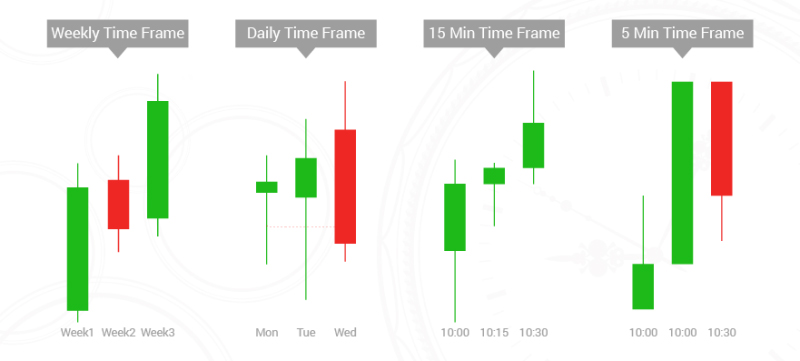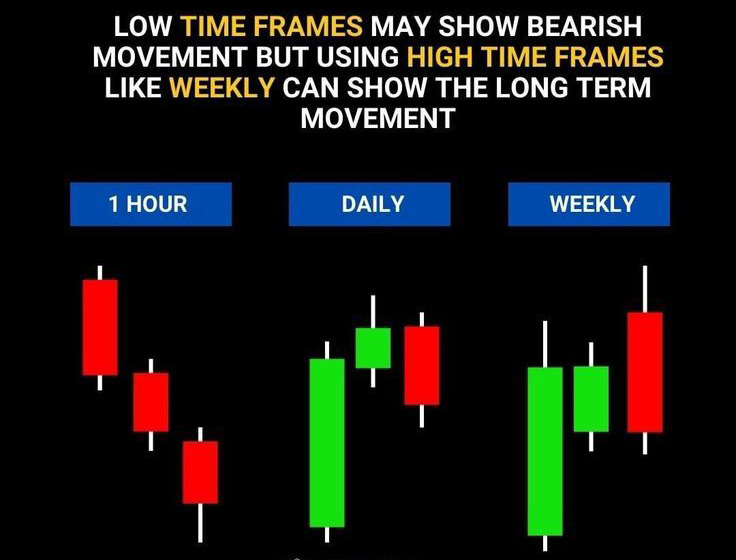What you are about to read:
The currency market, also known as Forex or FX, is the largest financial market in the world. With a daily trading volume exceeding 5 trillion dollars, it is a highly liquid and volatile market that offers numerous opportunities for profit to traders. However, trading Forex requires a deep understanding of various factors that influence the market, including the time frame in forex, which we will discuss in this article from Brokerland.
What is Time Frame in Forex?
A time frame in forex marker refers to the duration of the charts used in Forex trading. They can range from seconds to several years, and each one has its own characteristics and advantages. To understand what a it is and choose the best time frame, a comprehensive understanding of different trading strategies based on their timeframes is necessary. In the following, we will examine various timeframes in different Forex strategies and discuss their importance in trading.
Scalping (Seconds to Minutes)
Scalping is a short-term trading strategy that involves opening and closing trades within a few seconds to a few minutes. The goal of scalpers is to make small profits from small price fluctuations using market volatility. Depending on their trading strategy, they use charts with time frames ranging from seconds to minutes, such as one-minute or five-minute charts.
Scalping requires a high level of skill and discipline because traders must make quick decisions based on rapid market changes. It is also a high-risk strategy, as even a small price movement against the trader can result in a loss. It is suitable for experienced traders who have a deep understanding of the market and can quickly react to changes.
Day Trading (Minute to Hour Time Frames)
Day trading is a strategy that involves opening and closing trades within a single day. For Day traders, the best time frames are ranging ones from minutes to hours, such as 15-minute or one-hour charts. The goal of day traders is to profit from small price movements occurring during the day, but they do not hold their positions overnight.
Day trading requires significant time and effort, as traders must continuously monitor the market throughout the day. They also need a proper trading plan and risk management strategy to minimize losses. Day trading is suitable for traders who have the time and resources to execute trades throughout the day.
Swing Trading (Best Time Frame: Hourly to Daily)
Swing trading is a strategy that involves holding trades for several days to a few weeks. The best frames in forex for swing trading, range from hourly to daily, such as four-hour or daily charts. The goal of swing traders is to capture larger price movements by holding their positions for a longer duration.
Swing trading requires a strong understanding of technical analysis and market principles. Traders must identify forex trends and patterns present in the market and make informed decisions based on them. They also need a robust risk management strategy to prevent significant losses. This strategy is suitable for traders who have a calmer trading style and can maintain their trades for several days or weeks.
Position Trading (Week to Month)
Position trading is a long-term strategy that involves executing trades for several weeks to a few months. Position traders use charts with different time frames ranging from weeks to months, such as weekly or monthly charts. The goal of position traders is to achieve significant price changes by maintaining their positions for an extended period.
This strategy requires a deep understanding of market fundamentals and a long-term perspective. Traders must identify trends and underlying factors guiding the market and make informed decisions based on them. A strong risk management strategy is also necessary to prevent significant losses over a long period. Position trading is suitable for traders with a patient and disciplined approach to trading.
What is the Best Time Frame?
There is no one-size-fits-all answer to the best time frame in Forex, as it depends on the individual trader’s style and goals, as mentioned above. Each one has its own advantages and disadvantages, and the choice should be based on the trader’s risk tolerance, trading style, and overall trading strategy.
For traders who prefer a short-term trading approach and aim for quick profits, timeframes of 1 minute to 15 minutes may be suitable. This approach requires traders to closely monitor the market and make quick decisions based on rapid price changes.
For traders who prefer a more relaxed trading approach and intend to capture price changes over a longer period, time frames of 4 hours to daily may be appropriate. This approach involves holding positions for several days to weeks, allowing traders to capture larger price movements without the need for continuous market monitoring.
For traders who prefer a long-term trading approach, weekly or monthly time frames may be suitable. This approach involves holding trades for several weeks to a few months, allowing traders to capture significant price movements over an extended period while minimizing the impact of short-term market fluctuations.
Can we use more than one time frame in a forex trading?
Yes, traders often use multiple time frames in a forex trade to gain a better understanding of the market and increase their chances of success. This approach is known as Multiple Time Frame Analysis (MTFA).
MTFA involves analyzing the market using different timeframes to obtain a comprehensive view of the market trend and price movements. Traders often use a higher time frame to identify the overall trend and a lower one to pinpoint entry and exit points.
For example, a trader may use a daily chart to identify the long-term trend and a 1-hour chart to identify precise entry and exit points. The daily chart provides an overview of the overall market trend, while the 1-hour chart offers more accurate entry and exit points based on short-term price movements.
Using multiple time frames in forex trades can provide traders with a more complete picture of the market and allow them to make more informed trading decisions. It can also assist traders in identifying trends and price movements that may not be apparent within a specific time frame.
However, it is essential to note that the use of multiple timeframes in forex trades requires precise analysis and interpretation of charts. Traders must accurately identify trends and patterns and have a sound trading strategy and risk management plan to prevent significant losses.
Conclusion
In conclusion, in this forex learning article from Brokerland, we addressed the question of what a time frame in forex is and highlighted its crucial role in trading. Each timeframe has its own characteristics and advantages, and traders must choose one that aligns with their trading style and objectives. Therefore, determining the best time frame is subjective and depends on the individual trader’s preferences and goals. The choice of the best one is influenced by the trader’s strategy, whether it be scalping, swing trading, day trading, etc. There is no one-size-fits-all solution, and traders should select the most suitable time frame based on their unique trading approach.












